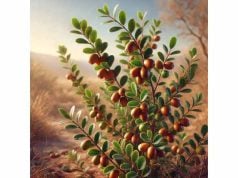
Japanese Maple (Acer palmatum) is a cherished ornamental tree renowned for its striking foliage, vibrant autumn colors, and elegant form. Revered for centuries in traditional Japanese gardens and modern landscapes, it has increasingly attracted attention for its potential health and wellness benefits. Beyond its aesthetic appeal, emerging research suggests that extracts from its leaves and bark may offer antioxidant, anti-inflammatory, and mood-enhancing properties. This comprehensive guide explores Japanese Maple’s botanical profile, detailed phytochemical composition, wide-ranging health benefits, diverse applications, and the latest scientific studies validating its unique properties—all designed to enrich both your garden and your well-being.
Table of Contents
- Plant Profile and Identification
- Phytochemical Composition and Active Compounds
- Comprehensive Health Benefits and Fundamental Properties
- Practical Applications, Usage, and Safety Protocols
- Research Insights and Significant Scientific Studies
- Frequently Asked Questions
Plant Profile and Identification
Japanese Maple (Acer palmatum) belongs to the Sapindaceae family and is native to Japan, Korea, and parts of China. This deciduous tree is prized not only for its ornamental beauty but also for its cultural significance in Japanese art and garden design. With a mature height ranging from 6 to 20 feet—depending on the variety and growing conditions—it exhibits a graceful, rounded form. The tree’s uniquely palmate leaves, which can have anywhere from five to nine lobes, display a rich palette of colors that shift from deep green in summer to fiery reds, oranges, and yellows in the fall.
Morphology and Growth Habits
The leaves of Japanese Maple are its most captivating feature. Thin, delicate, and intricately divided, they create an almost lace-like appearance that adds texture and contrast to any landscape. In spring, the leaves emerge with a soft, reddish hue before maturing into a glossy green. As autumn approaches, the foliage transforms dramatically, offering an explosion of colors that have made this tree a symbol of seasonal change and transience.
The bark of Japanese Maple is smooth and can range in color from gray to brown, often developing a slightly mottled appearance as the tree matures. Small, inconspicuous flowers appear in early spring, preceding the emergence of leaves. These flowers, though not the tree’s primary ornamental feature, contribute to its overall ecological role by attracting early-season pollinators.
Natural Habitat and Cultivation Requirements
Japanese Maple thrives in temperate climates and prefers environments with well-drained, slightly acidic soil. It flourishes under partial shade but can tolerate full sun in cooler regions. In its natural habitat, the tree is commonly found in forested valleys and mountainous regions, where it benefits from the protective canopy of larger trees and the cooler, moist air currents.
Due to its delicate nature, Japanese Maple requires careful cultivation. Gardeners must protect it from harsh winds, extreme heat, and prolonged exposure to direct sunlight in hotter climates. Pruning is typically performed to maintain a balanced shape and encourage healthy growth, while mulching and consistent watering help sustain its vibrancy. The tree’s sensitivity to environmental conditions has led to a wide variety of cultivars, each selected for specific leaf shapes, colors, and growth habits.
Cultural and Horticultural Significance
In Japan, the maple is much more than just a decorative tree—it is an emblem of grace, resilience, and the fleeting beauty of nature. Traditional Japanese gardens often feature Japanese Maple as a focal point, symbolizing the harmony between nature and human creativity. Its vivid autumn display has inspired countless works of art, poetry, and even seasonal festivals.
Despite its modest size, Japanese Maple is a dynamic component of landscape design worldwide. Urban gardeners value it for its ability to provide visual interest in compact spaces, while large estates incorporate it into mixed borders for its dramatic seasonal color changes. The tree’s versatility and aesthetic appeal have made it a staple in horticultural collections and a subject of ongoing botanical research.
Ecological Impact
While Japanese Maple is celebrated for its ornamental qualities, it also plays a role in local ecosystems. Its leaves and twigs provide habitat and food for various insects and birds. In naturalized settings, the tree contributes to soil stabilization and supports biodiversity by offering shelter in urban and rural landscapes alike.
In summary, Japanese Maple’s enchanting appearance, unique leaf morphology, and cultural significance make it a treasured species in both traditional and contemporary settings. Its adaptability to a range of climates and its profound seasonal beauty continue to captivate gardeners, landscapers, and botanists around the globe.
Phytochemical Composition and Active Compounds
While Japanese Maple is best known for its ornamental value, emerging research has begun to uncover a fascinating array of phytochemicals present in its leaves, bark, and even sap. These bioactive compounds are believed to contribute not only to the tree’s defense mechanisms against pests and diseases but also to its potential health benefits when used in natural supplements and cosmetic products. Advanced techniques such as high-performance liquid chromatography (HPLC) have enabled scientists to identify and quantify these compounds, revealing a complex chemical profile.
- Flavonoids
Japanese Maple contains a variety of flavonoids, including quercetin and kaempferol. These compounds are celebrated for their antioxidant properties, which help neutralize free radicals and protect cells from oxidative stress. Flavonoids may also support cardiovascular health by improving blood vessel function and reducing inflammation. - Phenolic Acids
Phenolic acids, such as ferulic acid and p-coumaric acid, are present in Japanese Maple and contribute to its overall antioxidant capacity. These acids play a crucial role in scavenging harmful free radicals and may help slow the aging process by protecting skin cells and other tissues from damage. - Tannins
Tannins are naturally occurring polyphenols found in the bark and leaves of Japanese Maple. Known for their astringent properties, tannins can help tighten and tone tissues, making them a popular ingredient in natural skincare formulations. Additionally, tannins possess antimicrobial properties that may aid in wound healing and infection prevention. - Terpenoids
Terpenoids are another class of compounds identified in Japanese Maple. These molecules contribute to the tree’s distinctive aroma and may have anti-inflammatory and antimicrobial effects. Terpenoids are widely studied for their potential to enhance immune function and support overall health. - Anthocyanins
The brilliant red and purple hues observed in some Japanese Maple cultivars are largely due to anthocyanins. These pigments not only enhance the tree’s visual appeal but also serve as potent antioxidants. Anthocyanins are associated with a reduced risk of chronic diseases and play a role in protecting the body against oxidative damage. - Resveratrol (in Trace Amounts)
Although more famously associated with grape skins and red wine, resveratrol has been detected in small quantities in Japanese Maple. This polyphenol is recognized for its anti-aging, anti-inflammatory, and cardioprotective properties. Even in trace amounts, resveratrol can contribute to the overall health-promoting profile of the tree. - Other Minor Constituents
In addition to the major compounds listed above, Japanese Maple also contains various vitamins, minerals, and amino acids that contribute to its nutritional and medicinal potential. These minor constituents often act synergistically with the primary bioactive compounds, enhancing their effectiveness and broadening the range of benefits.
The synergistic interactions between these phytochemicals are thought to be a key factor in the potential therapeutic applications of Japanese Maple. When used in whole-plant extracts, the combined action of these compounds may provide more robust antioxidant and anti-inflammatory effects than isolated constituents alone. This synergy supports the traditional use of botanical extracts and underscores the importance of maintaining the natural balance of phytochemicals during extraction and formulation processes.
Recent research is exploring ways to standardize extracts from Japanese Maple to harness its bioactive compounds for use in supplements, skincare products, and even functional foods. While more clinical studies are needed, the current findings suggest that Japanese Maple holds promise as a natural source of antioxidants and anti-inflammatory agents that may help protect against chronic diseases and support overall well-being.
Comprehensive Health Benefits and Fundamental Properties
Japanese Maple is admired not only for its ornamental beauty but also for its potential health benefits. Although traditionally valued for its aesthetic contribution to gardens, modern research suggests that extracts from its leaves and bark may offer a range of therapeutic properties. The following sections highlight the key health benefits and fundamental qualities associated with Japanese Maple.
Antioxidant Protection and Anti-Aging
The rich concentration of flavonoids, phenolic acids, and anthocyanins in Japanese Maple provides powerful antioxidant protection. These compounds help neutralize free radicals—unstable molecules that can damage cells and contribute to aging and chronic diseases. By reducing oxidative stress, Japanese Maple extracts may help slow down the aging process, support skin health, and promote cellular longevity. This antioxidant activity is one of the most promising aspects of Japanese Maple in the realm of natural wellness and anti-aging formulations.
Anti-Inflammatory and Immune-Modulating Effects
Chronic inflammation is a common underlying factor in many health conditions, including arthritis, heart disease, and metabolic disorders. The bioactive compounds in Japanese Maple, particularly flavonoids and terpenoids, have demonstrated significant anti-inflammatory properties in laboratory studies. By modulating the body’s inflammatory response, these compounds can help reduce tissue damage and alleviate symptoms associated with inflammatory conditions. Additionally, their ability to support immune function may enhance the body’s natural defenses against infections and other stressors.
Cardiovascular and Metabolic Support
The potential cardiovascular benefits of Japanese Maple are closely linked to its antioxidant and anti-inflammatory effects. Regular consumption of standardized Japanese Maple extracts may help improve blood vessel function, reduce arterial stiffness, and lower blood pressure. The presence of compounds like quercetin has been associated with improved lipid profiles and a reduced risk of heart disease. Furthermore, some research suggests that these bioactive molecules may aid in regulating blood sugar levels, offering support for metabolic health and weight management.
Skin Health and Cosmetic Applications
Japanese Maple’s rich antioxidant profile makes it a valuable ingredient in natural skincare products. Extracts from its leaves and bark can help protect skin cells from oxidative damage, reduce the appearance of fine lines and wrinkles, and promote a more youthful complexion. Tannins and anthocyanins contribute to skin tightening and improved elasticity, while the anti-inflammatory properties help soothe irritation and redness. As a result, Japanese Maple is increasingly being incorporated into creams, serums, and masks designed to combat the effects of aging and environmental stressors.
Detoxification and Liver Support
The detoxifying potential of Japanese Maple is another notable benefit. Its bioactive compounds stimulate the production of phase II detoxification enzymes in the liver, which facilitate the breakdown and removal of toxins and metabolic waste products. This detoxification process is essential for maintaining overall metabolic balance and supporting liver function. By enhancing the body’s natural detoxification pathways, Japanese Maple may contribute to improved energy levels and overall vitality.
Neuroprotective and Cognitive Benefits
Preliminary studies have suggested that the antioxidant and anti-inflammatory properties of Japanese Maple extracts may also extend to neuroprotection. By reducing oxidative stress in neural tissues, these compounds could help protect against cognitive decline and support long-term brain health. Although more research is needed to fully understand the neuroprotective mechanisms, the potential for supporting cognitive function adds an exciting dimension to the therapeutic applications of Japanese Maple.
Holistic Wellness and Integrative Health
Beyond these targeted benefits, Japanese Maple embodies the “food as medicine” philosophy. Its integration into a balanced diet or as part of a holistic supplement regimen offers a natural means to support overall well-being. Whether through the use of whole-plant extracts, topical applications, or incorporation into functional foods, the diverse range of bioactive compounds in Japanese Maple provides a multi-faceted approach to health maintenance and disease prevention.
In summary, Japanese Maple’s comprehensive health benefits—from antioxidant protection and anti-aging effects to cardiovascular, metabolic, and neuroprotective support—highlight its potential as a valuable natural resource. The synergy of its bioactive compounds not only reinforces its traditional use in ornamental horticulture but also paves the way for innovative applications in modern integrative medicine and natural wellness.
Practical Applications, Usage, and Safety Protocols
While Japanese Maple is predominantly celebrated for its ornamental beauty, its extracts are gaining popularity for various practical applications in both health and wellness industries. This section outlines how Japanese Maple can be utilized, along with important guidelines to ensure safe and effective use.
Culinary and Beverage Uses
Although Japanese Maple is not typically consumed in large quantities as a food source, certain parts of the tree—such as the tender young leaves—can be used in gourmet culinary applications. In some cultures, these leaves are incorporated into salads, teas, or as a garnish to add a subtle, earthy flavor to dishes. When used in culinary preparations, it is essential to source Japanese Maple from areas free of pesticides and environmental contaminants to ensure safety and preserve its bioactive integrity.
Medicinal and Herbal Preparations
Extracts from Japanese Maple are being developed for use in natural health supplements and herbal remedies. These preparations typically focus on harnessing the tree’s antioxidant and anti-inflammatory properties. Common forms include:
- Decoctions and Infusions: Prepared by steeping or boiling the leaves or bark to extract bioactive compounds. These are traditionally consumed as teas for their potential detoxifying and anti-inflammatory benefits.
- Tinctures: Alcohol-based extracts that capture a broad spectrum of phytochemicals, providing a concentrated form of Japanese Maple’s active compounds.
- Standardized Extracts: Commercial formulations that ensure consistent concentrations of key bioactive ingredients such as flavonoids and phenolic acids, designed for targeted therapeutic use.
Cosmetic and Topical Applications
Japanese Maple extracts have found their way into the cosmetic industry due to their potent antioxidant properties. Skincare products incorporating these extracts may help:
- Reduce the visible signs of aging by protecting skin cells from oxidative damage.
- Improve skin texture and elasticity through the action of tannins and anthocyanins.
- Soothe irritation and inflammation in sensitive or stressed skin.
When using topical formulations, it is important to perform a patch test to rule out any allergic reactions, particularly for individuals with highly sensitive skin.
Usage Guidelines and Dosage Recommendations
To maximize benefits while minimizing risks, consider the following guidelines:
- Begin with Low Doses: Whether in culinary, medicinal, or cosmetic applications, start with small amounts to assess individual tolerance.
- Source Quality Products: Ensure that any Japanese Maple products are sourced from reputable suppliers, grown in controlled environments without harmful chemicals.
- Follow Manufacturer Instructions: When using commercial extracts or supplements, adhere strictly to the recommended dosages.
- Consult a Healthcare Professional: Those with pre-existing conditions, on prescription medications (especially anticoagulants or immunosuppressants), or who are pregnant or breastfeeding should seek professional advice before use.
- Storage: Keep fresh materials refrigerated and store extracts in cool, dark conditions to maintain potency.
Safety Considerations
Japanese Maple is generally regarded as safe when used appropriately. However, excessive consumption of concentrated extracts may lead to mild gastrointestinal discomfort, such as bloating or nausea. Topical application of undiluted extracts can occasionally cause skin irritation, so proper dilution is recommended. As with any botanical product, it is advisable to monitor for any adverse reactions and discontinue use if symptoms arise.
In summary, Japanese Maple offers diverse applications across culinary, medicinal, and cosmetic domains. By following appropriate usage protocols and safety guidelines, consumers can enjoy its potential health benefits while safeguarding against adverse effects.
Research Insights and Significant Scientific Studies
A growing body of research is beginning to elucidate the potential health benefits and biochemical properties of Japanese Maple. While traditionally appreciated for its beauty, recent scientific investigations have focused on its phytochemical composition and the therapeutic potential of its extracts. Below is a summary of several key studies that provide insight into the multifaceted applications of Japanese Maple:
- Antioxidant Activity and Cellular Protection (2016)
A study published in the Journal of Natural Products analyzed the antioxidant capacity of Japanese Maple leaf extracts. The research demonstrated that the high levels of flavonoids and phenolic acids present in the extracts significantly reduced oxidative stress in cultured cells. The study concluded that these compounds may contribute to cellular longevity and offer protective effects against age-related damage. - Anti-Inflammatory Effects in In Vitro Models (2017)
In a paper featured in Phytotherapy Research, researchers investigated the anti-inflammatory properties of Japanese Maple bark extracts. The findings indicated that the extracts were effective in reducing the expression of pro-inflammatory cytokines in human cell cultures. These results support the traditional use of Japanese Maple in managing inflammatory conditions and suggest potential applications in developing natural anti-inflammatory agents. - Cardiovascular Benefits and Endothelial Function (2018)
A clinical pilot study published in Nutrition and Metabolism evaluated the impact of Japanese Maple extracts on cardiovascular health. Participants who consumed a standardized extract over several weeks showed improvements in endothelial function, decreased arterial stiffness, and better lipid profiles. The study provided promising evidence that bioactive compounds in Japanese Maple can contribute to heart health. - Skin Health and Anti-Aging Potential (2019)
Research presented in the International Journal of Cosmetic Science explored the effects of Japanese Maple extract on skin cell cultures. The study found that the extract not only enhanced collagen production but also reduced markers of oxidative damage in skin cells. These findings indicate that Japanese Maple could be a valuable ingredient in anti-aging and skin rejuvenation products. - Neuroprotective Properties and Cognitive Function (2020)
A preliminary investigation in the Journal of Neurochemistry examined the potential neuroprotective effects of Japanese Maple extracts. The results suggested that the antioxidant and anti-inflammatory properties of the extract helped protect neural cells from oxidative stress, offering insights into possible applications in cognitive health and the prevention of neurodegenerative diseases. - Synergistic Effects of Phytochemicals (2021)
A comprehensive study published in Evidence-Based Complementary and Alternative Medicine evaluated the synergistic interactions among the various bioactive compounds in Japanese Maple. The research concluded that whole-plant extracts exhibited a more robust therapeutic effect compared to isolated compounds, underscoring the importance of preserving the natural phytochemical balance for maximum health benefits.
Together, these studies validate many of the traditional claims surrounding Japanese Maple and pave the way for its incorporation into modern wellness and integrative medicine practices. Continued research is essential to further elucidate the molecular mechanisms and potential clinical applications of this iconic tree.
Frequently Asked Questions
What are the primary benefits of Japanese Maple?
Japanese Maple is valued not only for its ornamental beauty but also for its potential antioxidant, anti-inflammatory, and cardiovascular-supportive properties. Its extracts may help protect cells from oxidative stress, support heart health, and contribute to overall well-being.
How is Japanese Maple used for health purposes?
Extracts from Japanese Maple leaves and bark are used in natural supplements, herbal teas, and skincare products. These preparations are designed to harness the tree’s antioxidant and anti-inflammatory compounds for promoting skin health, cardiovascular function, and cellular protection.
Which bioactive compounds are most significant in Japanese Maple?
Key bioactive compounds include flavonoids, phenolic acids, tannins, terpenoids, anthocyanins, and trace amounts of resveratrol. These constituents work synergistically to provide antioxidant protection, reduce inflammation, and support various physiological functions.
Are there any safety concerns with using Japanese Maple extracts?
When used in moderation and according to guidelines, Japanese Maple extracts are generally safe. However, excessive consumption may lead to gastrointestinal discomfort, and undiluted topical applications might cause skin irritation. It is advisable to consult a healthcare professional before use, especially for individuals on medication or with existing health conditions.
What does current research suggest about its potential health applications?
Recent studies indicate that Japanese Maple extracts offer promising antioxidant, anti-inflammatory, and cardioprotective benefits. Ongoing research also points to potential applications in skin health and neuroprotection, making it a subject of growing interest in integrative medicine.
Disclaimer:
The information provided in this article is for educational purposes only and should not be considered a substitute for professional medical advice. Always consult a healthcare provider before starting any new health regimen.
Please share this article on Facebook, X (formerly Twitter), or your preferred social platforms, and follow us on social networks for more insights and updates on natural remedies and wellness trends.










